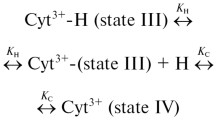Abstract
The crystal structures of dithionite-reduced bovine Cu(I),Zn superoxide dismutase and of its adducts with the inorganic anions azide and thyocyanide have been determined in a C2221 crystal form obtained at pH 5.0. This crystal form is characterized by a high solvent content (72%) and by having the two Cu,ZnSOD monomers (A and B) in different crystal environments. One of them (B) is involved in few intermolecular crystal contacts so that it is in a more "solution like" environment, as indicated by average temperature factors which are about twice those of the other monomer. The differences in crystal packing affect the active site structures. While in the A monomer the Cu(I) is coordinated to all four histidine residues, in the B monomer the bridging His61 side chain is found disordered, implying partial detachment from copper. The same effect occurs in the structures of the anion complexes. The inorganic anions are found bound in the active site cavity, weakly interacting with copper at distances ranging from 2.5 to 2.8 Å. The copper site in the A subunit of the native enzyme structure displays significant electron density resembling a diatomic molecule, bound side-on at about 2.8 Å from the metal, which cannot be unambiguously interpreted. The crystallographic data suggest that the existence of the His61 bridge between copper and zinc is dominated by steric more than electronic factors and that the solution state favors the His61 detachment. These structures confirm the existence of an energetically available state for Cu(I) in Cu,ZnSOD where the histidinato bridge to zinc is maintained. This state appears to be favored by tighter crystal contacts. The binding of the anions in the active site cavity is different from that observed in the oxidized enzyme and it appears to be dominated by electrostatic interactions within the cavity. The anion binding mode observed may model the substrate interaction with the reduced enzyme during catalysis.
Similar content being viewed by others
Author information
Authors and Affiliations
Additional information
Received: 22 December 1997 / Accepted: 30 April 1998
Rights and permissions
About this article
Cite this article
Ferraroni, M., Rypniewski, W., Bruni, B. et al. Crystallographic determination of reduced bovine superoxide dismutase at pH 5.0 and of anion binding to its active site. JBIC 3, 411–422 (1998). https://doi.org/10.1007/s007750050251
Issue Date:
DOI: https://doi.org/10.1007/s007750050251




